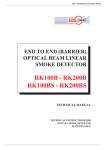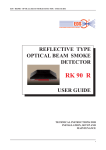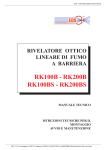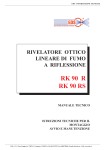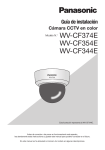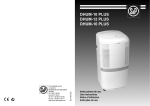Download EDS RK100B User guide
Transcript
EDS - RK90R - OPTICAL BEAM SMOKE DETECTOR - USER GUIDE END TO END (BARRIER) OPTICAL BEAM LINEAR SMOKE DETECTOR RK100B - RK200B USER GUIDE TECHNICAL INSTRUCTIONS FOR INSTALLATION, SETUP AND MAINTENANCE 1 EDS - RK90R - OPTICAL BEAM SMOKE DETECTOR - USER GUIDE CHAPTER INDEX 1 - Qualified Personell 2 -Normative references 3 - Installation 4 - Cable Connections 5 - Electrical Connections and Initial Setup 6 - Operation 7 - Optical Allignment 8 - Set up of the Obscuration circuit 9 - Set up of Turbulence circuit 10 - Detector’s activation 11 - Autocompensation 12 - Operational Test 13 - Fault Output 14 - Alarm Memory and Configuration Data 15 - Frintal Led Indication 16 - Maintenance 17 - Technical Data 2 EDS - RK90R - OPTICAL BEAM SMOKE DETECTOR - USER GUIDE STANDARD STARTING CONDITION (Read ahead) • SW1 - position 1 (minimum threshold level) • SW2 - position 1 (minimum threshold level ) • SW3 - position 4 (maximum Trasmitter power ) • JP1 - position 2-3 (optical allignment ON) • JP2-JP3 - position 2-3 (alarm and turbulence relays NC) • JP4 - position 1-2 (Fault relay NC) • JP5 - position 1-2 (memory OFF) • JP7 - not insert (alarm relay deactivated) • P1 - adjustment trimmer at half scale 3 EDS - RK90R - OPTICAL BEAM SMOKE DETECTOR - USER GUIDE QUICK INSTALLATION The procedure below is intended for trained personell with previous experience in installing EDS Beam Smoke Detectors RK100B and RK200B. If you don’t have the needed experience please refer to the standard installation procedure of this manual. 1 - Fix the RK100B detector (TX + RX) 2 - Connect the cables 3 - Make the optical allignment with the lamp 4 - Set SW3 switch on the TX according to the distance TX/RX (see table in fig.7) and power up the TX 5 - Set the JP2-JP3-JP4-JP5-JP7 jumpers on the RX (see pag.10) 6 - place RX jumper JP1 in “ON” position (Alignment) power up the RX device. 7 - Optimize the device signal using: • • • • the adjustment screws V1-V2-V3 on the optical block on the TX the P1 trimmer on the RX a multimeter (or the STS01 instrument) Orange/Red Led signal level indication (fig.8 board) 8 - regulate the signal between 4,7V and 5V with the P1 trimmer 9 - select the desired sensitivity of the Obscuration circuit with the SW2 selector (40-50-60-70%) 10 - select the desired sensitivity of the Turbulence (Heat) circuit with the SW1 selector (if used) 11- Check the detector’s operation by obscuring the TX or the RX 12 - set JP1 in the OFF position to activate the device 13 - close the cover within 5 minutes 14 - wait at least 5 minutes for the device to become operational 15 - perform operational tests 4 EDS - RK90R - OPTICAL BEAM SMOKE DETECTOR - USER GUIDE GENERAL Note : the following instructions are suitable for the RK100B and RK200B models. The RK100/200B is a new conception of optical beam smoke detector barrier. It’s composed by a Transmiter and a Receiver, and bases its working concept on the interaction between the smoke present in a room and an infrared beam emitted by the Transmitter and directed to the Receiver placed on the opposite wall of the room to be protected. For a correct installation, we recommend to read and follow our instructions carefully. The excellent working results of the device will widely compensate the time spent reading these instructions. 1 - QUALIFIED PERSONNEL 1.1 - All the operations of installation, setup, startup, maintenance and verifications of operation of the RK100/200B detector must only be performed by qualified personnell. These people are qualified for their experience, specialization courses, knowledge of the current standards and of the technical specifications, features and usage method of the product.. These people therefore are able to avoid errors or damages and assure an optimal functioning of the product. 2 - NORMATIVE REFERENCES 2.1 - For the installation in European Community countries you must follow the EC standard EN5414 (Fire detection and fire alarm systems). In extraeuropean countries you must respect the relevant internatiobnal and national standards. 5 EDS - RK90R - OPTICAL BEAM SMOKE DETECTOR - USER GUIDE 3 - INSTALLATION 3.1 - For the installation of the RK100/200B we suggest to use, besides the normal tools (drill, expansion plugs, etc), also the following elements: • 1 - 7mm “C” key • 1 - alignment lamp (we recommend to use our LAL02 lamp or an electric torch with a powerful and contrated beam) • 1 - tester (we recommend an analogic hand Tester or our analogical plugged on the special connector positioned on detector’s circuit. STS01 meter (optional) to be 3.2 - Remove the TX and RX cover acting on the 4 fixing screws set on the 4 angles of the cover (fig.2). 3.3 - Install the Transmitter at a distance from the ceiling within the 10% of the height of the room to protect. This distance can be varied by the system designer if particular environmental conditions exist. Wall fixing must be done with care using the 4 holes provided inside the container. If the wall is a solid masonry one, 4 expansion plugs are enough. It’s extremely important that the fixing wall or surface is rigid and not subject to deformations. 3.4 - install the Receiver on the opposite wall and at the same height of the Transmitter. It is not necessary that the device is perfectly in front of and perpendicular to the receiver (angle mistake up to 5 degrees is possible in all directions). We recommends, for the cables economy, to install the Receiver in the nearest position to the alarm control unit. 3.5 - get the cables inside through the holes obtained breaking the suitable zones marked on the sides of the detector’s base.. 6 EDS - RK90R - OPTICAL BEAM SMOKE DETECTOR - USER GUIDE 4 - CABLE CONNECTIONS 4.1 - the low detector’s power consumption (20 mA with normally open alarm relay contact (NO) and 30 mA with normally closed alarm relay contact (NC)) allows to use small size sections cables. We suggest to use a shielded cable with 8 conductors + shield ( 2x0,75 mmq for power conductors + 6x0,22 mmq for the signal conductors) for a distance up to 1 Km. In such way it is possible to get a remote connection of the following signals: • alarm relay contact (terminals C1-N1) • turbulence (heat) alarm relay contact (terminals C2-N2) • fault relay contact (terminals C3-N3) • analog signal output (terminal SIG - for level signal measurement from distance) The shield of the cable must be connected as in fig.14. 7 EDS - RK90R - OPTICAL BEAM SMOKE DETECTOR - USER GUIDE 5 - ELECTRICAL CONNECTIONS AND INITIAL SETUP 5.1 - Connect the device cables as shown on the labels facing the terminal board. The given symbols indicate what follows: • (V+) - (V -) - supply’s terminals 11 - 30 Vdc • (C1) - (N1) - normally closed alarm relay contact. The connection is valid when the detector is not in alarm state and JP2 jumper is in 2 - 3 position. If JP2 is positioned on 1-2 the contact results normally open. C1-N1 terminals are voltage free • (C2) - (N2) - turbulence alarm normally closed contact relay. Connection is valid when the detector is not in an alarm state and JP3 jumper is in 2 - 3 position.. If JP3 is positioned on 1-2 the contact results normally open. C2-N2 terminals are voltage free • (C3)-(N3) - normally closed fault relay contact. Fault relay is normally powered (intrinsic safety). Connection is valid when the detector is not in fault state and JP4 jumper is in 1 - 2 position. If JP4 is in 2-3 position the contact is normally open. C3-N3 terminals are voltage free. • (SIG) - 0-5V analog output terminal. To use only during allignment. 8 EDS - RK90R - OPTICAL BEAM SMOKE DETECTOR - USER GUIDE 5.2 - Jumper Settings JP1- to enter/exit the optical alignment procedure. To activate the procedure of optical alignment JP1 must be in 2-3 (ON) position. To deactivate the procedure of optical alignment JP1 must be in 1-2 (OFF) position. • JP1 position 2-3 (ON).......alignment procedure on • JP1 posizione1-2 (OFF)... alignment procedure off JP2 - JP3 - JP4 to set the output contacts respectively of Alarm relay, Turbulence relay and Fault relay to normally closed NC or normally open NO (cap. 5.1) The RK100/200B detector is normally factory preset with normally closed NC contacts. For the alarm relay the indication of JP2 is valid if JP7 is in OFF position. JP5 - activate the alarm memory function or to deactivate that function (detector automatically resets alarm output) • position 1-2 alarm memory off. When the detector gets out of alarm condition it automatically resets alarm output • position 2-3 alarm memory on. In case of alarm the detector’s alarm output persists until power supply is switched off for at least 5 seconds JP6 - microprocessor reset (SW reset) JP7 - selection of alarm relay operational mode : normally powered or not powered • JP7 ON - relay of alarm normally powered (in case of alarm the relay gets not powered). In this case the indication of the JP2 is inverted • JP7 OFF - relay of alarm normally not powered (in case of alarm the relay gets powered). In this case the indication of JP2 is according to figures 12-13-14 (diagrams of the terminal block and the classical scheme of connection to a control system to terminated lines) 9 EDS - RK90R - OPTICAL BEAM SMOKE DETECTOR - USER GUIDE 6 - OPERATION 6.1 - the RK100/200B detector is equipped with 2 circuits of detection of the smoke produced by a fire: • Obscuration - circuit sensitive to obscuration. This circuit bases its operation on the attenuation of the infrared beam intensity, along the optical path between the transmitter and the receiver, caused by smoke presence. • Turbulence - circuit sensitive to turbulence. During the beginning phase of a fire, generally there are some clouds of smoke and warm air that rise up to the ceiling. When these clouds and warm air intercept the infrared beam produced by the detector, they cause a perturbation of it, because they generate changes of optical and physics characteristics in the transmission mean of the infrared beam. This variations are obviously time related. An suitable circuit has been designed to detect these variations and, when these reach the programmed amplitude and the duration in time, an alarm signals generated. The sensitivity of this circuit is independently adjustable to fully satisfy the specific application needs. The advantage offered by this circuit is a great speed of fire detection, because it is detected in dynamic way in its initial phase. 10 EDS - RK90R - OPTICAL BEAM SMOKE DETECTOR - USER GUIDE 7 - OPTICAL ALIGNMENT 7.1 - proceed with the optical alignment of Transmitter TX and Receiver RX. To facilitate the operation we suggest to do it in low ambient light conditions and to proceed in the following way: • place in front of the Receiver (fig.3) an optical alignment lamp able to project a concentrated and sufficiently intense light beam. (we recommend the EDS alignment lamp LAL02) • direct the light beam of the lamp to the lenses of the Transmitter • look at the screen that is behind the lens, inside the Transmitter. On it you will see a bright point that represents the image of the lamp • move the optical block using her special screws V1-V2-V3 with a key, so that the bright point falls in the center where a small hole is present through which the photodiode is visible (fig.4). It’s important that the bright point falls on the photoemitting zone of the photodiode. This zone is represented by the small dark dot in the center of the photodiode. In such way the TX will be alligned with the RX. After doing the optical alignment of the Transmitter it is necessary to do the optical alignment of the Receiver. To do that you have to repeat the operations previously described in this paragraph. 11 EDS - RK90R - OPTICAL BEAM SMOKE DETECTOR - USER GUIDE 8 - SETUP OF THE OBSCURATION CIRCUIT Electric signal setup must be performed according to the following sequence: 8.1 - do not power up the TX and the RX 8.2 - on the Transmitter (TX) rotate the selector SW3 in one of the positions 1-2-3-4 (fig.10) according to the distance between TX and RX with reference to fig.7 8.3 - power up the TX and don’t mount the cover. The red led of the TX will pulse every 10 seconds 8.4 - on the Receiver (RX) move the alignment jumper JP1 (fig.9) in the position ON (Alignment) to activate the initial setup operation mode 8.5 - power up the Receiver 8.6 - the blue led and the red one will start working in the way described ahead in chap. 8.13. Before going on to this chapter read what’s following 8.7 - the P1 trimmer (regulation of the signal level) is factory preset to the 50-60% and it corresponds to a signal of 5V at the maximum distance 8.8 - to get the best results in the following operations, we recommend the use a measuring instrument (Multimeter), preferably an analog hand type, for better control of the variations of the signal during the setup. Good results are also obtained using analogical STS01 (optional), designed for this application, that must be inserted on the special connector CN4, set on the printed circuit of the detector (v. fig. 11). If you don’t have a Multimeter or the STS01, you can perform the setup operations anyway evaluating the signal level with the frontal Leds indications as described in chap.8.13 8.9 - if available, connect a 5V fullscale multimeter between the SIG terminal and the negative power supply one and read the analog output signal. Instead of the multimeter it is possible to use the STS01 meter (optional - fig. 11). If the output signal is very low it means that the operations of optical alignment described in chapter 5 have not been performed in the right way and therefore must be repeated 8.10 - the Transmitter emits a conic beam which form and dimension, in relation with the distance between TX and RX, are explained in figures 5 -6. It’s important that the Receiver is in the center of the Transmitter conic beam because, under these conditions, even if some small movements of the wall on which the transmmietter is mounted on happen (caused by deformations), the reflector remains always within the beam and therefore active. To obtain this, the operations of fine centering with output signal measuring, explained below, must be performed with care. 8.11 - adjust the signal around 3V acting on the trimmer P1 (fig.9) 12 EDS - RK90R - OPTICAL BEAM SMOKE DETECTOR - USER GUIDE 8.12 - search for the maximum output signal optimizing the optical alignment of the Transmitter acting slowly and in sequence on the 3 screws of regulation V1-V2-V3 present on the optical block. This procedure takes some time but, if performed well, it assures a perfect operation of the detector for many years. We suggest to use the following procedure: • on the TX slowly turn the screw V1 clockwise and then look at the value of the signal visualized on the multimeter on RX. If the signal increased (for example from 3V it rised to 3,5V) then again turn the screw V1 of the TX clockwise and then look at the value of the signal on the RX • continue with this procedure as long as the signal on the RX increases. When it has the tendency to decrease instead, stop the operation on the screws V1 of the TX returning to the previous position • if during the operation the signal overcomes 4,5V, to avoid the saturation, act on the trimmer P1 of the RX to bring the signal back to 3 V, allowing the best evaluation of the variations of the signal • after finding out the maximum og the signal acting on the screw V1, perform the same operations on the screws V2 and V3 of the TX. In such way the best possible position of optical allignment is reached. This procedure is important because it will assure a perfect operation of the detector for long time 8.13 - if you don't have a multimeter it is possible to get good results in the optical alignment of the detector as well, looking at the RX blue and red leds indications. Operation is the following: • 1 flash of the blue Led: 1 Volt • 1 flash of the red Led: 0,5 Volts • if the signal is smaller of 0,5V the blue led and red one are off • if the signal in the range 0,5-1 V the red led performs 1 flash, remains off for 2 seconds and then it repeats the sequence • if signal is among 1-1,5 V the blue led flashes once, remains off for 2 seconds and then it repeats the sequence • if signal is among 1,5-2V the blue led flashes once and the red led flashes once. They remain off for 2 seconds and then the sequence is repeated • if signal is among 2-2,5 V the blue led flashes 2 times, remains off for 2 seconds and then it repeats the sequence • if signal is among 2,5-3V the blue led flashes 2 times and the red led flashes once. They remain off for 2 seconds and then the sequence is repeated • same type of indication up to 4 V 13 EDS - RK90R - OPTICAL BEAM SMOKE DETECTOR - USER GUIDE • if the signal overcomes 4 V, the blue Led flashes faster and faster as the frequency signal increases up to 4,7V • when the signal overcomes the 4,7V and in the range 4,7V - 4,9V, the blue led is continously ON. This is the position of optimal setup • if the signal gets over 4,9V the two blue and red leds are permanently on. This is the saturation indication. The table of fig.8 recaps the leds operation. 8.14 - install the cover of the TX 8.15 - after closing the cover of the TX and performing the operations of fine optical alignment using the multimeter, the STS01 meter or the indications of the leds, adjust the output signal on the RX to a level between 4,7-4,9V, slowly turning the trimmer P1. When the signal is in this range, the blue led is continously on. This is the signal level of optimal setup. If the signal rises to 5V the detector gets in saturation and the blue and red leds are both on. It is necessary to decrease the signal to 4,7-4,9V acting on P1so that the red led turns off and only the blue one remains on (to avoid saturation). Attention! - this regulation is not critical. The procedure above indicated it is that optimal, however it is enough that the blue Led is flashing or stably ON to have one good setting. It is necessary yet to avoid the saturation (red Led ON). The microprocessor automatically compensates the inaccuracies of the setting. 8.16 - select the alarm threshold level of the circuit sensible to obscuration acting on the selector SW2 with the following possible choiches : • • • • position 1 - low sensitivity - obscuration alarm threshold set to 70% position 2 - low to medium sensitivity - obscuration alarm threshold set to 60% position 3 - medium to high sensitivity - obscuration alarm threshold set to 50% position 4 - high sensitivity - obscuration alarm threshold set to 40% 8.17 - sensitivity must be regulated according to the environmental situation. The setting must normally be a medium sensitivity level, but in case of dusty and perturbed environments it will be useful to set a lower sensitivity level. 14 EDS - RK90R - OPTICAL BEAM SMOKE DETECTOR - USER GUIDE 9 - SETUP OF THE TURBULENCE CIRCUIT 9.1 - The RK100/200B detector is equipped with a special additional circuit for the detection of air Turbulence (heat). This circuit is independent from the classic obscuration one and in particular situations it can be used to increase the performance of the detector. If these particular situations are not present the Turbulence circuit can be left unused. 9.2 - This circuit is particularly useful when, for environmental reasons, the linear optical beam smoke detectors must be installed at distances from the ceiling higher than the nominal. When the fire begins, it produces smoke clouds and hot air bubbles that go up. When these bubbles intercept the infrared beam they perturbate it because they produce a change of the optical-physical characteristics of infrared beam. These changes are obviusly correlated in time. This circuit is been projected to detect these changes and, when these changes reach the programmed width and time lenght, an alarm signal is generated. The advantage of this circuit is the quicker fire detection, because the fire is detected in its beginning phase. A typical example is the complete protection of the dome of a church with important pictures on its surface. The linear optical beam smoke detectors must be installed at the baseline of the dome and therefore much lower than the ceiling. In this case using the turbulence (heat) detection circuit is very useful to improve the detection. 9.3 - selection of the sensitivity level of the circuit sensitive to Turbulence(heat). The operation is performed acting on selector SW1 of the RX that has 4 positions (fig.9). • sensitivity increases from 1 to 4 • position 1 : minimum sensitivity • position 4 : maximum sensitivity Regulation must be performed with caution because with an higher sensitivity a quicker response time is obtained, but also the probability of false alarm is increased. So the sensitivity selection must be done according to the environmental conditions. If these conditions are good an high sensitivity regulation is possible. If in the environment, because of the normal working conditions, dust's clouds, vapor or smoke are systematically produced, it will be necessary to adjust the sensitivity to a lower level, so that these factors doesn't generate false alarms. 15 EDS - RK90R - OPTICAL BEAM SMOKE DETECTOR - USER GUIDE 10 - DETECTOR’S ACTIVATION 10.1 - on the RX, put the jumper of Initial Setup, JP1, in OFF ALI (mark on circuit) position (alignment off) 10.2 - the blue alignment led flashes in a certain way (2 slow flashes - a delay - 2 fast flashes and then this sequence is repeated) 10.3 - install the cover of the RX. This closing operation must be done within 5 minutes. The level of the signal will be decreased because of the attenuation caused by the cover 10.4 - the inside electronics wait 5 minutes for the installation of the cover and then perform a quick procedure (1-2 minutes) to get the RK100B output signal level back to 4,7-5V 10.5 - after this activation procedure, the detector becomes operational. The blue alignment led switchs off (detail chap.10.2) and it begins to flash as described in 10.6 10.6 - every 10 seconds the blue led will give out a short flash that indicates the normal operation of the detector. In case of alarm the frontal red led will light up and remain switched on until the alarm state is present or, if the memory function is activated, until the power supply is removed for at least 5 seconds (v. chap.14) 11 - AUTOCOMPENSATION 11.1 - the inside electronics of the detector is equipped with a special function of autocompensation of the signal. If the detector is installed inside a particularly dusty place, the dust that is deposited on the front of the TX and RX causes a drop of the output signal level. This decrease is automatically eliminated by the autocompensation. 16 EDS - RK90R - OPTICAL BEAM SMOKE DETECTOR - USER GUIDE 12 - OPERATIONAL TEST 12.1 - verification of the circuit sensible to obscuration The verification is done simply darkening the TX or the RX with an opaque screen. After 10 seconds, the RX alarm relay must activate / deactivate (chap.5.2 - jumper JP7) and the frontal alarm red led must be switched on. After that, remove the screen and the alarm relay must be switched red led switchs off, and the blue led returns to flash every 10 seconds. If the function of memorization is activated (v. chap.14), it is necessary to remove the power supply from the RX for at least 5 seconds to remove the persistence of the alarm indication. 12.2 - verification of the circuit sensible to turbulence. Place and remove an opaque screen in front of the RX several times with the following sequence (dark / light) and selecting the corresponding sensitivity with SW1 selector: • • • • position 1........... 2 second dark - 2 second light for 10-12 times position 3.... .......2 second dark - 2 second light for 8-10 times position 2........... 2 second dark - 2 second light for 6-8 times position 4............2 second dark - 2 second light for 4-6 times After the correct sequence the turbulence relay must be activated. 17 EDS - RK90R - OPTICAL BEAM SMOKE DETECTOR - USER GUIDE 13 -FAULT OUTPUT 13.1 - the fault relay contact is available on the terminal block of the RX. This relay is normally activated and will be deactivated if at least one of the following conditions are verified: • the output signal falls below the 90% preset value (optical beam completely interrupted by an obstacle) • the circuit of autocompensation has reached its limit (when this happens it is necessary to do some maintenance on the detector) • operation fault (detectors’s circuit malfunction) Attention: the current standards indicate that the fault output can be used for remote signaling, but must not be used for inhibiting the alarm signal 14 - ALARM MEMORY AND CONFIGURATION DATA 14.1 - the receiver of the RK100B is equipped with alarm memory that can be activated / deactivated with the JP5 jumper (fig.9): • jumper JP5 in position 1-2 - memory deactivated (OFF) • jumper JP5 in position 2-3 - activated (ON) When the alarm memory is activated, if the detector gets in alarm, the alarm output relay and the frontal red led remain activated until the alarm condition gets off and power supply is removed for at least 5 seconds. When the memory is not activated, if the detector gets in alarm the alarm output relay and the red frontal led are deactivated as soon as the alarm condition gets off. 14.2 - memory of configuration and settings data. In case of lack of power supply the internal memory retains the data. When the power supply is back the detector, after a setup time of 2 minutes, returns to normal operation 15 - FRONTAL LEDS OPERATION 15.1 - the frontal leds of the RX during the normal operation of the detector, give out the following indications (see fig.9): • normal operation: the blue led flashes every 10 seconds alarm: the red Led lights up • limit of compensation, interrupted beam, fault: the blue Led flashes every second 18 EDS - RK90R - OPTICAL BEAM SMOKE DETECTOR - USER GUIDE 16 - MAINTENANCE 16.1 - the instrument requires an easy and periodic maintenance. It can be programmed or made automatic using remote signaling of the detector. During the normal operation and after a certain time from installation, if maintenance is not performed, the detector, because of the dirt and dust deposited on the front of the covers, gives out a fault output signal, because of the decrease of the signal below the limit of compensation. Then it will be time to proceed to cleaning in order to reestablish the initial optical conditions. 16.2 - The operations to be done are the following : • remove power supply • verify the terminal board tightening the terminals in acse they are loose • verify the optical alignment in case some changes of the structure on which the instrument is mounted or in the environment took place. In this case repeat the operations of chap.8 • perform the cleaning of the front covers of TX and RX We suggest to use a wet cloth with water with some trace of soap. Chemical products like alcohol, ammonia and similar must not be used. The cleaning of the frontcover is fundamental for the good operation of the device • restore power supply 17 - SENSITIVITY SELECTION 17.1- Afer the installation and after some working period, if you want to modify the sensitivity of the detector, read what follow: • remove the cover of the receiver (it is not necessary to power off the detector) • modify the sensitivity acting on the SW2 selector • close the cover 19 EDS - RK90R - OPTICAL BEAM SMOKE DETECTOR - USER GUIDE TECHNICAL DATA • • • • • • • • • • • • • • • • • • • • • • • • • • • • • • • Models: RK100B, RK200B Type: Barrier Optical Beam Smoke Detector Manufacturer: EDS srl - V. Cà Nova Zampieri 6 - 37057 S.G. Lupatoto - Verona - ITALY Power Supply: 12/24 Vdc Power Supply Range: 11- 30 Vdc Max Optical path: 120 m for RK100B 200 m for RK200B Max cover area.: 1.600 sm (EN54-14 standard) Protection against the inversion of polarity Digitally codified infrared beam Power Consumption of TX: 9,5 mA Power Consumption of RX: 18,6 mA in normal operation 34 mA with the alarm relay activated 34 mA with the turbulence relay activated 50 mA with both alarm and fault relay activated Maximum angular missallignment of the detector: +/- 0,5° Selection of the obscuration alarm threshold level with a 4 positions switch: position 1 - 70% position 2 - 60% position 3 - 50% position 4 - 40% Selection of the turbulence alarm threshold level with a 4 positions switch Alarm Relay activation delay: 10 s Fault Relay activation delay: 5 s Detector's recovery time with alarm memory dectivated: about 5 s Detector's recovery time with alarm memory activated: about 5 s (power supply off) Working temperature: -10 + 55°C Red LED indication: alarm status Blue LED indication: compensation limit, interrupted beam, fault Alarm Relay: 1A/24 V dc Turbulence Relay: 1A/24 V dc Fault/Maintenance Relay: 1A/24 V dc 0-5 V Analog Output for signal level measuring/visualization Dimensions: 247 x 146 x 114 mm. Housing: autoextinguishing policarbonate box Relevant Standard: EN 54-12 Certifications: EN54-12/CPD (0786-CPD-20803), VDS2504-VDS2344 (G209131) Protection Index: IP 65 (IEC 529-144) Weight: 900 gr. 20 EDS - RK90R - OPTICAL BEAM SMOKE DETECTOR - USER GUIDE TX RX fig.1 A A A A fig.2 21 EDS - RK90R - OPTICAL BEAM SMOKE DETECTOR - USER GUIDE lampada LAL 02 rivelatore fig.3 disco bianco white disc foro hole diodo fotoemittente photoemitting diode fig.4 22 EDS - RK90R - OPTICAL BEAM SMOKE DETECTOR - USER GUIDE fig.5 RK200B RK100B diametro del raggio [cm] 150 75 140 70 130 65 120 60 110 55 100 50 90 45 80 40 70 35 60 30 50 25 40 20 30 15 20 10 10 5 0 0 distanza [m] 0 0 10 20 20 40 30 60 40 80 50 60 70 80 90 100 100 120 140 160 180 200 fig.6 23 EDS - RK90R - OPTICAL BEAM SMOKE DETECTOR - USER GUIDE DISTANCE SELECTION SW3 [TX] DETECTOR TYPE POSITION SW3 DISTANCE [m] 1 25-50 2 50-70 3 70-90 4 90-120 1 40-80 2 80-120 3 100-160 4 140-200 RK100B RK200B fig.7 24 EDS - RK90R - OPTICAL BEAM SMOKE DETECTOR - USER GUIDE RELATION VOLT - FLASHING VOLT N° Flash Blue Le d N° Flash Re d Le d < 0,5 OFF OFF 0,5-1 OFF 1 1-1,5 1 OFF 1,5-2 1 1 2-2,5 2 OFF 2,5-3 2 1 3-3,5 3 OFF 3,5-4 3 1 4-4,7 Variable -/+ OFF 4,7-4,95 Fix light OFF > 4,95 saturation Fix light Fix light fig.8 25 EDS - RK90R - OPTICAL BEAM SMOKE DETECTOR - USER GUIDE DS1651 LED di allineamento LED di Allarme V1 V2 P1 3 2 1 CN4 RX 9 Fehlerrelais V3 JP6 TURBO 1 2 3 SW1 JP7 1 ON 3 2 JP1 1 OFF ALI 2 3 4 SW2 ON 3 2 JP5 1 OFF MEM 3 2 1 JP3 Turborelais fault relay 3 2 1 JP4 Alarmrelais alarm relay 3 2 1 JP2 SENS 4 turbo relay 8 7 6 5 4 3 2 1 fig.9 26 EDS - RK90R - OPTICAL BEAM SMOKE DETECTOR - USER GUIDE RECEIVER INTERNAL ELEMENTS P1 - trimmer for the regulation of the signal level. Normally regulated to 50-60% that corresponds to a signal of 5V at the maximum distance SW1 - selector for the regulation of the sensitivity of the circuit sensible to Turbulence (heat). Sensitivity increases from 1 to 4. In position 1, minimum, in position 4, maximum SW2 - trimmer for the regulation of the sensitivity of the circuit sensible to obscuration • • • • low sensitivity - alarm level for obscuration at 70%, position 1 middle / low sensitivity - alarm level for obscuration at 60%, position 2 middle / high sensitivity - alarm level for obscuration at 50%, position 3 high sensitivity - alarm level for obscuration at 40%, position 4 V1-V2-V3 - scews for the regulation of the optical block CN4 - connector for the STS-01 meter (optional) JP1 - jumper for activate / deactivate the procedure of optical alignment. To activate the procedure of optical alignment JP1 jumper must be inserted (ON). To deactivate the procedure of optical alignment and therefore get the detector operational, the JP1 jumper must be disconnected (OFF) • JP1 position 2-3 (ON)......alignment procedure activated • P1 position 1-2 (OFF)...... alignment procedure deactivated JP2 - JP3 - JP4 - jumpers to set the relay contacts, respectively of the alarm relay, turbulence and fault normally closed NC or normally open NO. • position 1-2 - output contact normally open NO • position 2-3 - output contact normally closed NC JP4 must be in position 1-2 to have the contact closed because the fault relay is normally activated. The RK100/200B detector is normally factory preset with closed NC contacts. For the alarm relay the indication of JP2 is valid if JP7 is in OFF position JP5 - jumper to activate the alarm memory function or to deactivate such function (to get the auto Reset of the detector) • in position 1-2 memory deactivated. When it stops the state of alarm the detector him autoripristina (Auto Reset) • in position 2-3 memory activated . In case of alarm the shores-bearer remains in alarm until tension is not removed for 5 second JP6 - jumper of microprocessor Reset JP7 - jumper to set alarm relay operation normally powered or not powered • JP7 ON - alarm relay normally activated (in case of alarm deactivated). In this case the indication of the jumper JP2 inverted • JP7 OFF - alarm relay deactivated (in case of alarm activates). In this case the indication of the jumper JP2 is according JP6 - jumper to Reset the microprocessor 27 EDS - RK90R - OPTICAL BEAM SMOKE DETECTOR - USER GUIDE TRANSMITTER INSIDE PARTS DS1653 LED V1 V2 TX fig.10 V3 JP6 POWER 1 2 3 4 2 1 SW3 SW3 - selector for the regulation of the transmitter power (TX) - power increases from 1 to 4. Maximum power in the position 4 and mimimum in position 1. RECEIVER INSIDE PARTS WITH STS-01 METER DS1652 LED di allineamento LED di Allarme V1 V2 P1 RX fig.11 9 Fehlerrelais V3 JP6 TURBO 1 2 3 SW1 JP7 Turborelais fault relay 3 2 1 JP4 Alarmrelais alarm relay 3 2 1 JP2 SENS 4 1 ON 3 2 JP1 1 OFF ALI 2 3 4 SW2 ON 3 2 JP5 1 OFF MEM turbo relay 3 2 1 JP3 8 7 6 5 4 3 2 1 28 EDS - RK90R - OPTICAL BEAM SMOKE DETECTOR - USER GUIDE V- TERMINAL BLOCK OF THE TRANSMITTER V+ 2 alimentazione 11-30 Vcc 1 fig.12 SIG N3 C3 N2 TERMINAL BLOCK OF THE RECEIVER C2 N1 C1 fig.13 VV+ 9 segnale analogico 0-5V analog signal output 0-5V 8 7 contatto relè GUASTO FAULT relay contact 6 5 contatto relè TURBOLENZA TURBULENCE relay contact 4 3 contatto relè d'ALLARME ALARM relay contact 2 1 alimentazione 11-30 Vcc supply voltage 11-30 Vcc 29 EDS - RK90R - OPTICAL BEAM SMOKE DETECTOR - USER GUIDE CENTRALE DI CONTROLLO alimentazione + segnale analogico 0-5V contatto relè GUASTO SIG N3 C3 contatto relè TURBOLENZA N2 C2 contatto relè d'ALLARME N1 C1 9 - + schermo 8 7 resistenza di Allarme 6 5 4 3 2 alimentazione 11-30 Vcc connessione zona1 resistenza di fine linea V1 V+ fig.14 Example of connection of RK100/200B receiver with a zones control unit. In this case the detector is a zone of the system. The state of the indicated relays correspond to the normal operation condition of the detector. The alarm output is the one of the alarm relay (circuit sensible to obscuration in alarm) or the one from the turbulence relay (circuit sensible to turbulence (heat) in alarm). The turbulence relay, if not necessary, can be left unused. The fault output is the one from the NC contact of the fault relay of RK100/200B. The values of the resistances of Alarm and End of Line will be indicated by the control unit manufacturer. ACCESSORIES FOR RK100/200B LAL02 -Optical alignment lamp The RK series detectors on installation must optically aligned. This lamp is suitable to do an optimal alignment. The operation is done easily in a few minutes and it assures the full functionality of the detectors. The lamp has a L=15m cable for connection to a battery 12V for the power supply 30 EDS - RK90R - OPTICAL BEAM SMOKE DETECTOR - USER GUIDE EDS WARRANTY GENERAL CONDITIONS 1. OBJECT EDS S.r.l. - Via Cà Nova Zampieri 6, 37057 S. G. Lupatoto - Verona, Italy (hereinafter “EDS”), guarantees its products to be free from defects in materials or workmanship within the terms and conditions of this Warranty. A product found by EDS to be defective will be repaired or replaced, at the option of EDS, within 24 month after receipt of the product by EDS or an authorized EDS Service Center. Please note that in addition to this policy you may have specific legal rights granted by your national or state laws regarding warranties of consumer products. 2. NOT COVERED This warranty does not cover products which reached the end of their normal lifespan, does not cover damage resulting from accidents, alteration, neglect, misuse or abuse, lack of reasonable or proper maintenance, corrosion, improper assembly, repairs improperly performed or replacement parts improperly installed, use of replacement parts or accessories not conforming to EDS’s specifications, use of component parts not manufactured or supplied by EDS, modifications not recommended or approved in writing by EDS, normal wear and deterioration occasioned by the use of the product. This warranty also does not cover cosmetic imperfections in the surface, finish, or appearance of the product which were apparent or discoverable at the time of purchase of the product or damage occurring during shipment or transport of the product. This warranty also does not cover tools and other consumables or any expenses related to the transportation of the product to or from EDS or an authorized EDS Service Center. 3. PURCHASER This warranty is made only with the original purchaser of the product and does not extend to any third parties. The rights of the Purchaser under this warranty may not be assigned. 4. TERM The term of this warranty shall commence on the date of retail purchase and shall continue for a period of 24 month. 5. ENTIRE AGREEMENT This warranty supersedes any and all oral, express or written warranties, statements orundertakings that may previously have been made, and contains the entire Agreement of the parties with respect to the warranty of the product. Any and all warranties not contained in this Agreement are specifically excluded. 6. DAMAGES Except as expressly provided by this warranty, EDS SHALL NOT BE RESPONSIBLE FOR ANY INCIDENTAL OR CONSEQUENTIAL DAMAGES ASSOCIATED WITH THE USE OF THE PRODUCT OR A CLAIM UNDER THIS AGREEMENT, WHETHER THE CLAIM IS BASED ON CONTRACT, TORT OR OTHERWISE. The foregoing statements of warranty are exclusive and in lieu of all other remedies.Some states do not allow the exclusion or limitation of incidental or consequential damages, so this limitation or exclusion may not apply to you. 7. DISCLAIMER ANY IMPLIED WARRANTY OF MERCHANTABILITY OR FITNESS FOR A PARTICULAR PURPOSE AND ALL IMPLIED WARRANTIES ARISING FROM A COURSE OF DEALING, USAGE OF TRADE, BY STATUTE OR OTHERWISE, IS HEREBY STRICTLY LIMITED TO THE TERM OF THIS WRITTEN WARRANTY. This agreement shall be the sole and exclusive remedy available to the Purchaser with respect to the purchase. In the event of any alleged breach of any warranty or any legal action brought by the purchaser based on alleged negligence or other tortuous conduct by EDS, the Purchaser’s sole and exclusive remedy will be repair or replacement of defective materials as stated above. No dealer and no other agent or employee of EDS is authorized to modify, extend or enlarge this warranty. The performance of any warranty service under this Agreement is not an admission or agreement that the design or manufacture of a product is defective. 8. PROCEDURE In the event of a defect covered by this warranty, the purchaser should contact EDS - Via Cà Nova Zampieri 6, 37057 S. G. Lupatoto - Verona, Italy or an authorized EDS Service Center. To be honored, claims must be submitted within the 24 month warranty period (according to the product) and within eight (8) days of discovery of the defect. The determination whether the defect is covered by this warranty is within the sole discretion of EDS. EDS reserves the right to discontinue products and to change specifications for existing products at any time without notice and shall not be obligated to incorporate new features into products previously sold, even if those products are returned under a warranty claim. EDS may replace defective parts with similar parts of similar quality in the event that identical parts are unavailable. The purchaser must obtain advance authorization in writing before returning any product to EDS for warranty inspection. A return authorization number will be issued and must conspicuously appear on the outside of the product’s packaging. The issuance of an authorization number does not constitute acceptance of the claim, which will be evaluated by EDS upon its inspection of the product. The product should be cleaned and securely packed to prevent damage during shipment and must be accompanied by a letter specifying or including the following items of information: a) dated receipt or other proof of date of retail purchase; b) a copy of the warranty; c) EDS part number; d) detailed description of the problem experienced with the product, including a chronology of efforts made to correct the problem; e) identification of the components used in conjunction with the product; f) estimate of product usage: (i.e. accumulated mileage or time in service); g) your name, address, and written authorization to ship the repaired product back to you freight collect (“C.O.D.”); h) the product for repair must be shipped to EDS without any charge 9. APPLICABLE LAW Any disputes arising out of this Agreement or the use of this product will be governed by the laws of the country of Italy and will be decided by the Courts of Verona, Italy. 31 EDS - RK90R - OPTICAL BEAM SMOKE DETECTOR - USER GUIDE The technical information in this document have been carefully checked and can be considered reliable. In any case the EDS Company is not responsable for any eventual inaccuracy and reserves the right to make changes to any part of this document and/or to the products, in order to improve their quality, reliability or design. EDS - srl ELECTRONIC DETECTION SYSTEMS Via Ca' Nova Zampieri 6 37057 S.G. Lupatoto - VERONA - ITALY Tel: +39 045 547529 - Fax: +39 045 8750065 Web: www.eds.eu email: [email protected] 32
































